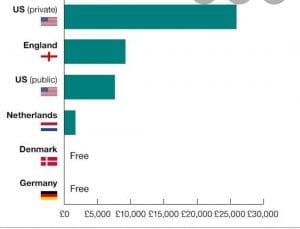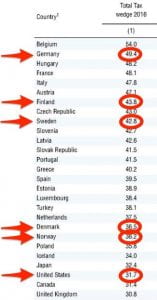Continue reading “Why haven’t we fixed the cost of education?”
Author: 1979nina
how do we get more equitable access to higher education?
The staggering cost of higher education in the United States has prospective college students wondering whether going to college is worth the expense. While conventional wisdom still points to the benefits of having a college degree, more students and their families are seeking alternatives to lower their college tuition bills. Some Americans are even looking abroad, as some countries offer free tuition to international students and programs of study entirely in English.Why the United State do not have free college education yet? If America were to move to a tuition free college policy, where the money come from? The object of this blog is to explain why the idea of free college education system works better in Sweden than what we have nationally in the U.S? https://www.investopedia.com/articles/personal-finance/080616/6-countries-virtually-free-college-tuition.asp
According to the concept map we have been creating with my group, which talk about the potential solution of higher college education. We have decided to look up on some countries where higher college education is free in order to see if those countries are way better than the U.S. We have been able to gather some sources.

Talking about free higher college education, the United States tuition fees are higher than most countries as we can see in the graphic. This graphic ties into my argument by showing the huge among tuition fees cost for student also by demonstrated that there are some countries that have free college education and that there are better than the U.S. So the question is why can’t the U.S vote for free college education? Countries like Germany , Sweden and so on have free college and this money come from the government. https://www.google.com/amp/s/www.washingtonpost.com/news/grade-point/wp/2016/08/26/three-ways-to-fix-college-tuition-pricing/%3foutputType=amp
As the US faces a higher education affordability crisis, students from developed countries do not pay anything for college. Of the 36 developed, democratic countries that currently make up the organization for economic cooperation and development (OECD), seven of them subsidize tuition for public colleges and universities. The US, in contrast, charge the most money to attend colleges among OECD countries. The average annual tuition for US public colleges cost more than $6,000, according to a 2011 report from OECD. businessinsider.com
- If we look at the those countries that have free college education and the US, we can see a huge differences. On one hand we have countries like Germany, Denmark, Sweden, that have free college on the other hand we have the US with who’s tuition are going up years after years. https://www.investopedia.com/articles/personal-finance/080616/6-countries-virtually-free-college-tuition.asp.
If America were to move to a tuition-free college policy, where would the money come from? The short and simple answer is taxes. Who gets taxed seems to vary based on who is talking, but it seems certain that the upper echelons of American society will see increased taxes if this passes. There is a likelihood that it will increase the upper-middle-class as well. Or maybe it will all come from Wall Street speculation taxes. The point is, all we know is that someone will pay these dues through taxes. The uncertainty of who will carry the burden is not making many Americans comfortable. https://www.collegeraptor.com/find-colleges/articles/affordability-college-cost/pros-cons-tuition-free-college/
European countries often differ greatly from the US in substantive ways. Their college enrollment percentages, for example, are much lower than in America.Europe also traditionally has higher taxes than the US, which allows those countries to offer additional social services.The Organisation for Economic Co-operation and Development (OECD) released its 2017 report on the tax burden on earnings among member countries.Their report ranks countries by their tax wedge percentage. The tax wedge is the dollar measure of the income tax rate. The countries below with the red arrows offer free college, with the exception of the US. There are other European countries that offer free college, but the countries below are the most well-known examples. https://www.businessinsider.com/how-do-european-countries-afford-free-college-2017-4

- https://www.businessinsider.com/how-do-european-countries-afford-free-college-2017-4. It is true that the idea of free college works better in Germany, Sweden than in America. The tuition has been payed by the State. the fact that the taxes are higher they still find a way to make free college education.
Finally, the government must work to reduce tuition costs because the current system of financial aid is not adequate. Many middle-class students find themselves in a predicament when filling out financial aid forms prior to enrolling in college. Many middle-class families have the paradoxical problem of having too high a net income to qualify for financial aid, but still do not have enough money to pay for college out of pocket. Students are then forced to rely on academic scholarships and loans. Academic scholarships are extremely competitive and often aren’t enough to pay for the entirety of a tuition bill. Currently, there are government funds available for students, but it’s become apparent that these simply aren’t enough. These grants have come under fire in the recent elections. Presidential candidate Mitt Romney frequently stated his plans to reduce the amount of money budgeted for Pell Grants and similar government grants. Grants do not need to be repaid by the recipient. The government needs to look at what other countries do for allowing free college education.
Why haven’t we fixed the cost of high education?
The Department of Education is a United States executive department which was establish in 1980. This Department is the third largest discretionary budget beside of that, it has a small staff. The Department of Education is represented by Betsy Devos who is actually the secretary. Along the way, we are going to demonstrate in the federal government, where the money come from and how much influence the federal government have over the cost of education? Also what could thy do.
Connect: the concept map is connect through what i am working on which is why haven’t we fixed the cost of high education by the federal government role.

This graphic ties into my argument because the department of education is part of the executive branch. The executive have an authority on education.
According to the U.S News, “government spending on education has surged over the last decade and a half, with money being funneled to federal programs for low-income students, students with disabilities and a slate of competitions that the Obama administration launched through the economic stimilus package. Since 2002, federal funding for education has increased by 36 percent, from $50 billion to $68 billion, according to an analysis by the Committee for Education Funding, a District of Columbia-based advocacy organization. It peaked in 2009 at $97 million, thanks to an injection of dollars from the economic stimulus, most of which went to staving off teacher layoffs”. https://www.usnews.com/news/blogs/data-mine/2016/01/14/federal-funding-where-does-the-money-go.
In addition to that we can say that in the federal government the money for education come from the Congress. According to “American Government” (p 53), Congress has the power to make laws such as borrow money, grant parents, and copyright.
If we ask ourselves how much influence the federal government have over the cost of education, we can say that based on Find a Lawyer, “The federal government also influences education by allocating funding only to those school districts that follow certain federal guidelines. Roughly three percent of the federal budget is spent on education as of 2017 – a small proportion, of course, but in many years this amounts to billions of dollars. Most of this money goes toward assistance programs for children with disabilities. The rest of the money is distributed to school districts under the every student succeeds act”. https://education.findlaw.com/curriculum-standards-school-funding/the roles-of-federal-and-state-governments-in-education.
Why does college cost so much?

There are many factors that make college so expensive, tuition, textbooks, and Administrative salaries.
Nowadays, college has become more expensive than before. “Theories suggest financial Aid causes tuition increases.” More we borrow money more tuition fees are higher. “In 19970, financial aid programs were nonexistent .” Meaning that college was more cheaper than today. businessinsider.com/why-is-college-so-expensive-2018-4
Students are spending almost half of their money on textbooks. Each year, publishers are making our life more difficult by publishing new textbooks. “Almost 80% of textbook industry is dominated by 5 publishing companies. they use restrictive codes and re-publish new versions of textbook.” By doing this, they are making students spend more and more on textbook that we are going to use only once. nypost.com/2015/09/05/heres-the-reason-why-your-college-textbooks-are-so-expensive/
According to David A. Tomar in New York Times, “salaries of full-time faculty members are, on average, barely higher than they were in 1970. Moreover, while 45 years ago 78 percent of college and university professors were full time, today halt of postsecondary faculty members are lower-paid part-time employees, meaning that the average salaries of the people who do the teaching in American higher education are actually quite a bit lower that they were in 1970.” thebestchools.org/magazine/why-college-expensive/
In conclusion, college is so expensive in many reasons. Tuition, textbooks. and administrative salaries are one of them that make college so higher. thebestchools.org/magazine/why-college-expensive/ , nypost.com/2015/09/05/heres-the-reason-why-your-college-textbooks-are-so-expensive/ , and businessinsider.com/why-is-college-so-expensive-2018-4 are the sources that can help me to found those information.